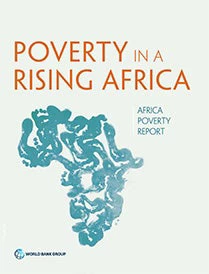
However, not only the level of inequality matters, but also the reasons behind it. Unequal outcomes may result from both differences in opportunities as well as differences in effort. There is also growing evidence and consensus that it is especially the former, which is pernicious for development. Rewards by effort may incentivize people. Yet, when welfare mainly differs because of differences at birth (such as gender, ethnicity, or parental background) or, more generally, because of factors beyond the individual control, it tends to be especially detrimental for economic growth and social harmony.
So, does inequality within Africa’s countries mainly follow from widely different efforts among its populations or is it mainly due to deep rooted differences beyond the individuals’ control? This is the question we set out to answer in the Inequality of Opportunity in Sub-Saharan Africa background paper to the poverty report. This is no easy task, conceptually, nor empirically, and even more so in data constrained environments as in Africa (see two recent discussions by economists Ferreira and Peragine and Roemer and Trannoy.)
Following the literature, we examine in particular how much of a country’s income (proxied by consumption) inequality can be explained by its population’s circumstances in childhood, i.e. its ethnicity, their parents’ education and occupation and their region of birth, and how much by individual responsibility, luck, or effort (obtained as the residual).
Drawing on 13 surveys collected between 2000 and 2013 we have tried to show what is the share of total inequality due to opportunity in 11 African countries. Unfortunately, the answer turns out to be rather sensitive to the method used. A possibility - in order to maximize comparability with estimates for other countries - is to endorse the typical “ex-ante” approach used to estimate inequality of opportunity. When using the mean log deviation as inequality measure, the share of inequality due to opportunity ranges between 12% and 33%.
However, other methods show a much larger share of total inequality explained by inequality of opportunity: our least conservative estimate, based on the Gini index, ranges between 26% for Rwanda and 44% for Malawi, and takes in general values between 30% and 40%. This is a striking result, particularly if one considers that the computed measures are only lower bound estimates of the inequality of opportunity level in each country. We also look at the association between total consumption inequality and inequality of opportunity (see Figure 1): although some re-rankings do exist, the data show a positive relationship between the two kinds of inequality.
Moreover, the sources of unequal opportunities differ across countries: for example, Malawi shows a large impact of parental education and a relatively smaller impact of ethnicity, while in the Democratic Republic of Congo and Guinea is the opposite.
In sum, data and methodologies are improving and we can today start to study inequality of opportunity in SSA countries; however, sensitivity to the method used is high and cross-countries comparability may be still limited.
What can we do, then, with these estimates? Measures of inequality of opportunity are especially relevant for country specific analyses, as they point out how circumstances beyond individual control such as ethnicity, birth location, and parental background contribute to determine individual outcomes; this evidence in turn dictates equality enhancing policy interventions, which could be tailored towards specific groups in the population.
Figure 1: total inequality and inequality of opportunity in SSA countries

This blog is part of a series reflecting on the findings of the 2016 World Bank Report “Poverty in a Rising Africa." Next in the series: inequality in Africa on Feb. 8, 2016. Previous blogs in the series include:
- Africa is rising! But are people better off?
- Who will fund poverty surveys in Volkswagen countries?
- The European refugee crisis: What we can learn from refugees in Sub-Saharan Africa
- Poverty is falling faster for female-headed households in Africa
- The shock of widowhood: Marital status and poverty within Africa
- Domestic Violence and Poverty in Africa: When a Husband’s Beating Stick is Like Butter
- Data gaps: The poor typical household survey’s miss




Join the Conversation